

How to Install PIAA 2000 Series XTreme White Plus Halogen Lights - Fog Beam - Pair on your 87-18 Jeep Wrangler YJ, TJ, JK & JL
Please read the cautionary points before installation to ensure safe utilization of the product.
● Do not touch the bulb while lit or immediately after switching it off because the lamp remains extremely hot. Severe burns may occur as a result. Also, care should be taken to prevent water from making contact with the lens.This may cause the lens to crack or impair proper functioning.
● The lamp becomes very hot when turned on. When parking your car near flammable items such as dried leaves, turn off the lamp as it may cause a fire.
● Do not look directly into the light for long periods. Doing so may cause eye irritation or visual impairment.
● The lamp and relay harness are intended for automobile use. Do not use for any other purpose.
● This lamp is intended for use in rain (day or night), during foggy or snowy conditions where visibility is hampered. Do not use during normal driving conditions.
● Do not operate the switch while driving.
● If the lamp is kept on when the engine is not running, it may drain the battery.
● Make sure the lamp is installed securely before driving the vehicle. If an abnormality is found, adjust it immediately.
● Check for any loose screws that hold the lamp in place before driving. If you find any loose screws or bolts (if a bracket is used), tighten them securely. If you notice a loose part while driving, inspect the section immediately and make the necessary adjustments.
● Avoid repeatedly turning the lamp off and on as it may reduce the overall life of the bulb.
● Depending on the model of the vehicle, a surge of high voltage may occur when starting the engine. In order to protect the bulb, avoid starting the engine with the lamp on or turning it on immediately after.
● Using bulbs with different specifications may cause an abnormality. When replacing bulbs, confirm the voltage, watt and type. We recommend using PIAA-approved bulbs. Refer to “[6]Bulb Replacement Procedures” when replacing bulbs.
● Avoid needless disassembly of lamp or relay harness as it may cause it to fail.
● If the lamp and/or relay harness is removed and set aside for safekeeping, wipe away all dust or grime and store in an place free of moisture.
● If a lens cracks, refer to “[6]Bulb Replacement Procedures” then disassemble the lamp and replace accordingly.
● If the lens is cracked or damaged in any way, verify whether there is any damage to the harness or the relay harness that it is connected to. If there is any damage to the cord covering, replace it immediately.
● Avoid injury when replacing the harness and relay harness. Please dispose of it as a non-combustible item.
● If a significant amount of water seeps in it may cause irreversible damage to the bulb. Please refer to “[7]Troubleshooting” section of this manual.
Please read the installation procedures thoroughly beforehand.
● This lamp is a hanging type and uses a bracket. If using it upright, set the bracket up correctly so that the PIAA logo is properly displayed.
● In order for the lamp to perform at its full potential, use relay harnesses manufactured by PIAA.
● All work procedures should be carried out in a location with adequate space. Place the shift lever in neutral or in the parking position. Turn off the engine and set the side brake.
● Make sure the engine compartment is adequately cool before starting work. Do not begin work if engine parts such as radiator, oil-cooler or turbo part are still hot.
● Be extremely careful when handling the lamp and relay harness. If dropped or excessive shock is applied to the lens, bulb or relay harness, it may cause irreversible damage.
● Do not add additional holes to the main body of the lamp. Also, do not apply adhesives or stickers to the lamp parts.
● Do not modify the lamp harness or the relay harness in any way. Such modifications may cause it to overheat or short. In some cases, it may cause the vehicle to catch fire. PIAA will not be liable for damage caused by such modifications.
● When removing the battery terminals, do not touch the (-) and ( ) terminals simultaneously. An electrical shock may occur. Wear rubber gloves when carrying out such work procedures.
● Make sure the (-) and ( ) terminals do not make contact with metal. It can be extremely dangerous if a short occurs.
● Make sure all bolts are tightly secure. If there are any loose bolts tighten them accordingly.
● After installing the lamp, adjust the lamp so the beam shines at least 40m in front of the vehicle. Also, adjust the lamp a little toward the left so that it does not shine directly into the eyes of the opposing driver of a vehicle. (as traffic laws stipulate - refer to p.8 for adjustment procedures)
● After installing the lamp, make sure the headlamps, wipers and horn are working normally.
● When the battery terminal is removed, memory related to the clock, radio, audio system etc, will be affected. After all work procedures are completed, reset to the original settings. (For adjustment procedures refer to your carʼ s instruction manual)
Caution Regarding Wiring / Please read thoroughly
● When doing wiring work, strictly follow the cautionary points mentioned below. Incorrect or faulty wiring may cause the lamp to operate improperly. In some cases, it may cause the vehicle to catch fire.
● Before you begin always remove the (-) and ( ) terminals. Always remove the (-) terminal first and make sure a short does not occur.
● When removing the battery terminals, always turn the key to OFF and remove it. Turn all other electrical units off such as the light switch.
● When removing the battery terminals, if a cord (for an electrical unit) is connected, wind a length of vinyl tape around the (-) and ( ) terminals to clearly identify them.
● Verify the ( ) terminal (white) and earth (black) before connecting.
● Do not obtain ( ) voltage from the alternator.
● Obtain the ( ) current necessary for the switch from the ( ) current used for the light switch. (Do not use the same current used for a computer, radio or audio system)
● Do not place the relay box where water can directly enter the unit.
● Install the relay harness in a position where it will not make contact with high temperature surfaces such as the engine, radiator or engine compartment.
● Arrange the relay harness so that it does not make contact with moving parts.
● Do not place the relay harness on high-voltage wires such as brake or air-conditioning wires.
● If the relay harness makes contact with a part of the engine, apply a length of ordinary cushioned tape around the harness.
● When connecting the connector, insert until you hear an audible “click”
● When removing the connector, hold the main body of the connector and pull it out. If excess force is used to pull the cord, it may damage the connection, which could cause it to overheat.
● Make sure the harness does not sag. Use a harness band of vinyl tape to secure it in place to wiring inside the engine compartment.
● Before connecting it to the battery, verify the wiring arrangement.
● When connecting the battery terminal and or other electrical units, do not mistake the (-) and ( ) terminals. Always start with the ( ) terminal.
● After all wiring is complete, confirm that it works properly. If it fails to activate, refer to “[7] Troubleshooting” section of this manual.
Using the holes in the lamp bracket, the height from the lamp body to the installation surface can be adjusted. Depending on the top and bottom measurements as well as shape.
Bracket position
Top/Bottom can be adjusted
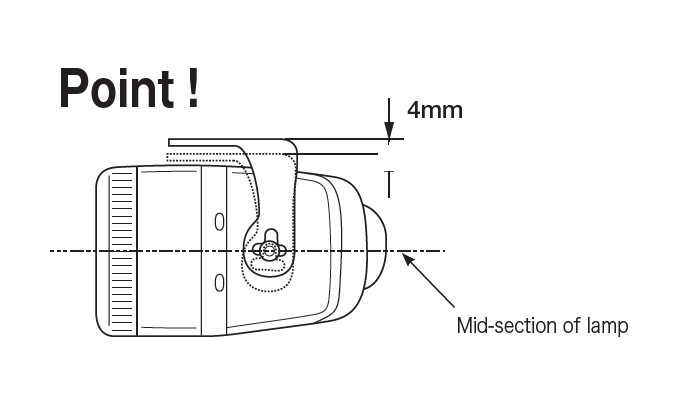
Where should it be installed?
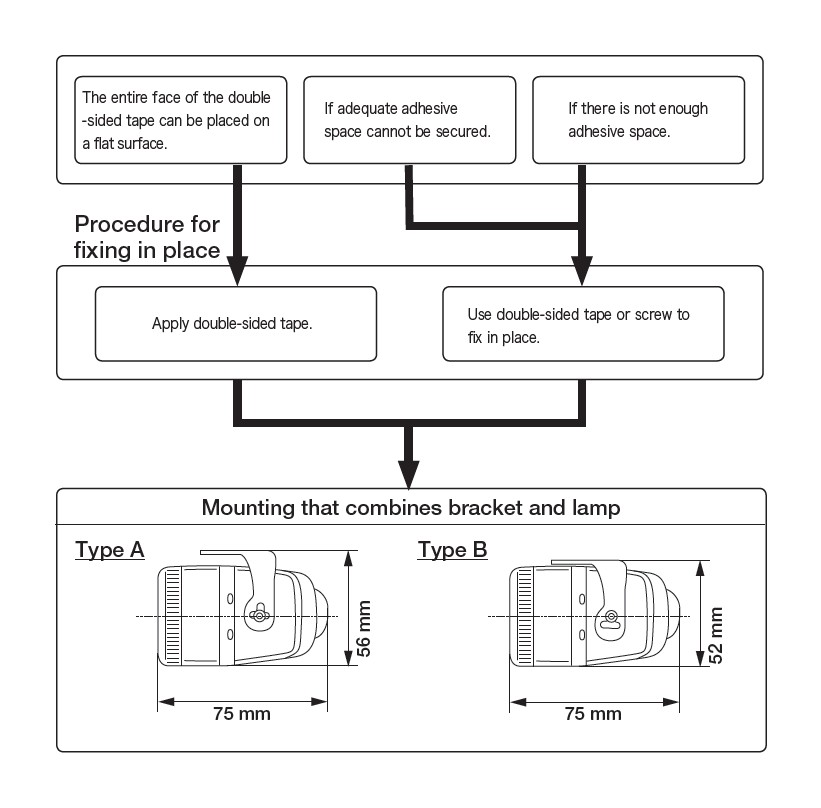
● Install the lamp body so it does not rub against the surface of the bumper. Heat may cause the plastic to deform. Allow between 5mm to 10mm between lamp body and vehicle part.
● When using a bracket available on the market, make sure the bolts you remove from the vehicle does not hinder its performance.
● Do not install on an unstable location, it may come lose while driving. This may affect the overall life of the bulb. In addition it may damage the vehicle or the main body of the lamp. Make sure you install the lamp on a stable and secure location.
When you have decided the installation method
(1) Rearrange the bracket according to your needs, and apply double-side tape (Item 3) and one-side tape as shown in the diagram below.
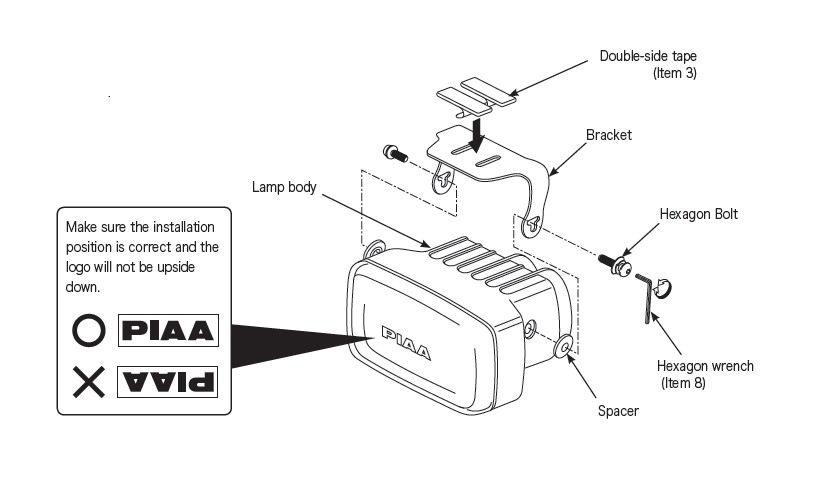
(2) Hold the lamp up to where it will be installed on the vehicle. Verify the gap between the lamp and surrounding obstacles.
Check !
● Make sure the lamp can be adjusted up and down (beam must be adjusted so that it shines at least 40m ahead of the vehicle.) If it cannot be adjusted, it must be re-installed.
● There must be between 30mm to 35mm on either side of the lamp to allow for proper adjustment.
● If using a screw, make sure there is adequate space between the bracket and the lamp (where screw will be inserted).
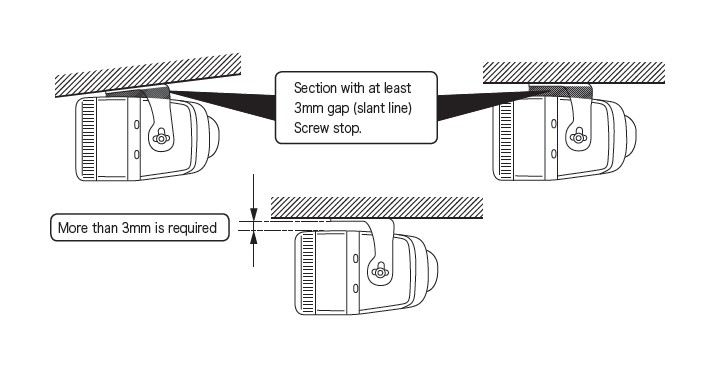
2. Relay Harness Installation Sequence
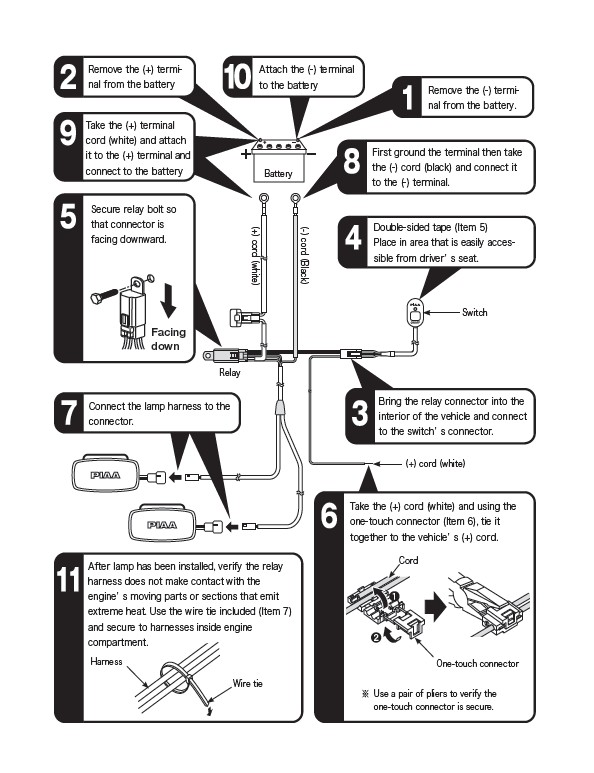
3. Lamp Installation Procedures
1. Temporarily set the bracket with masking tape and then mark the correct position.
● Make sure to set position properly before permanently setting the lamp. Also, thoroughly clean the surface of the installation position beforehand.
2. Remove the lamp harness and take out the lamp.
3. Install the lamp according to the marking made prior to installation.
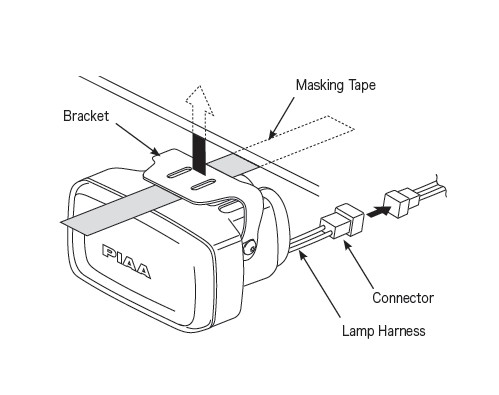
If using only the double-side tape
Peel the protective sheet from the double-sided tape (Item 3) and apply.
● When using the double-side adhesive tape, clean the surface where tape will be applied. Use a clean cloth or sponge and make sure dirt, grease, wax etc., are completely removed. If substances cannot be removed, it may not adhere properly. In particular, avoid using leather wax, tire wax and also any type of organic solvent.
● When used in low temperatures, the adhesive substance tends to lose its strength. Use a drier or simply warm up the adhesive surface before applying. When using a drier, avoid moving it too close to the bumper as it may cause it to deform.
● After installation, avoid excess speeds and do not wash for 1 to 2 days.
● If applied incorrectly, a special double-sided adhesive tape is available at your local PIAA dealer.
If screws are used
(1) Loosen the hexagon bolt with the wrench provided and remove the bracket from the lamp.
(2) Peel off the protective sheet from the double-sided tape and apply it to the bracket.
(3) Fix the bracket in place with the screws.
(4) Install the lamp onto the bracket.
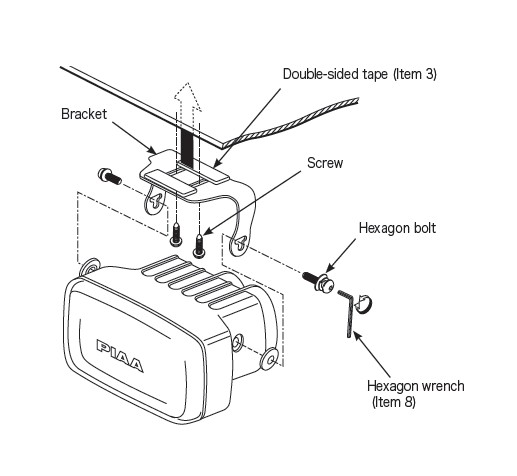
4. Fog Light Aiming
There are two important issues to address when installing fog lights, the first is to minimize the amount of return glare into the drivers eyes, and the other is to minimize glare into oncoming eyes. Both of those issues must be accomplished while putting as much light as possible on the road.
These fog/foul weather light aiming instructions are suggestions taken from common practice and the S.A.E. standard J583. Some modifications to these instructions may be necessary to minimize glare.
Visual aim is made with the top of the beam 4 inches below the lamp center at 25 feet with the lamp facing straight forward. (See below.)
● Only use fog lights if they are aimed properly. Fog lights should never be the only foreword light source. Fog lights should be used with headlamp low beams.
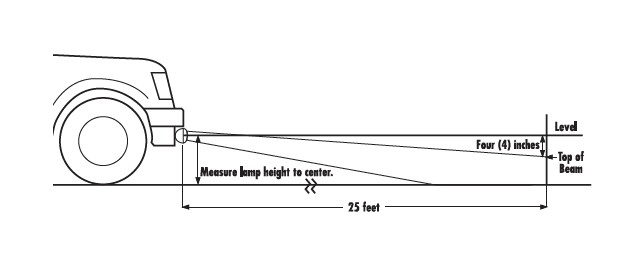
5. Caution When Replacing the Bulb
● Because there is high-pressure inside the bulb, do not apply excess pressure or scratch or damage it in any way. Damage to the bulb may cause injury. It may also affect the overall performance of the lighting system.
● Lighting the lamp without protection may cause it to burst and can be potentially dangerous. Do not activate without proper covering.
● Do not look directly into the light for long periods. Doing so may cause eye irritation or visual impairment.
● The lamp and bulb can radiate considerable heat while it is on or immediately after it is turned off. Considerable care must be taken to void getting burned. Do not touch with bare hands or make contact with skin. When carrying out replacement procedures always switch the power OFF and allow adequate time for it to cool down.
● Do not touch the glass section of the bulb or allow any grease or oil to get on to the glass. If it is not wiped clean it may cause the glass to crack or worse it may burst. If you touch it accidently or if stained in any way, use alcohol to wipe it clean before use.
● Do not allow water to permeate the bulb. If the bulb is used under such conditions it may cause it to break. If there is any evidence of water, wipe it away and allow it to dry before using.
● All work procedures should be carried out in a location with adequate space. The surface area should also be flat and level. Place the shift lever in neutral or in the parking position. Turn off the engine and set the side brake.
● Always set the fog lamp switch to OFF when carrying out work procedures.
● If disassembling the lamp for replacement purposes, do not pull the harness with excessive force. If the connecting section of the harness is damaged it may overheat posing significant danger.
● Hold the main unit firmly when connecting or removing the connector or terminal. Faulty connection may cause unnecessary damage to the bulb. Pulling the cable itself may also cause damage and overheating.
● Remove or insert connector and terminals at a straight angle. If excessive force is applied, it may damage the terminal or bulb.
● Verify the shape of the bulbʼ s metal fitting, and check the proper direction before inserting. Also, make sure to verify the harness connection. Improper installation may cause to the bulb to come lose or overheat. It can also minimize the life of the bulb.
● After replacing the lamp and reassembling the unit, make sure the harness is not inadvertently caught in the assembly. Such conditions may cause a short.
● Dispose of used bulbs properly (non-combustible) and avoid breaking the unit.
● Do not use the bulb without its protective covering. Inflammable material placed near it may catch fire.
6. Bulb Replacement Procedures
1. Loosen the 4 screws on the back of the lamp housing. Re-move the lens unit from the housing unit.
● When disassembling the lamp, do not pull with excessive force. If the harness section is damaged it may cause it to overheat.
● Make sure not to misplace the screws that were removed.

2. Move the sleeve aside and remove the ( ) harness from the bulb' s lead line.
3. While pushing the clasp holding the bulb holder, remove the bulb from the lens holder.
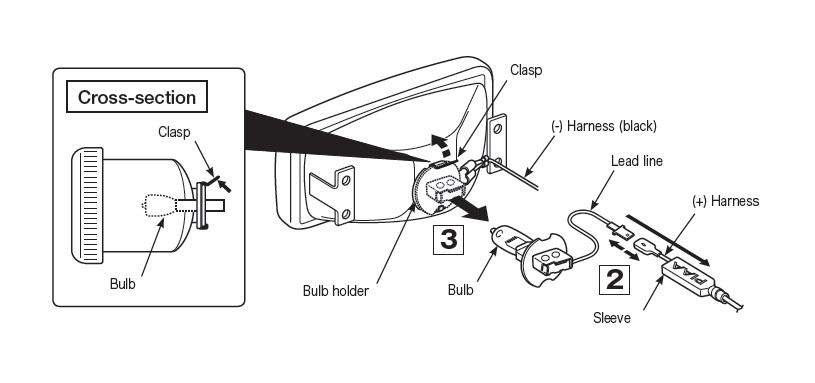
4. Set the end of the bulb holder to the round notch of the bulb' s metal fitting. Set so that the clasp catches on the
square notch located on the upper section of the bulb.
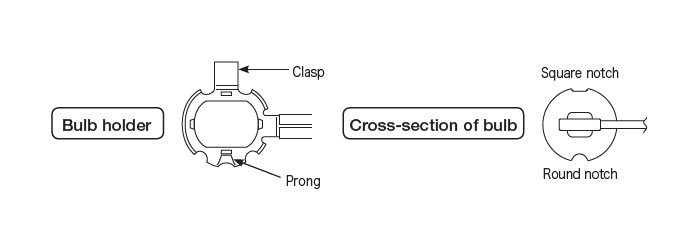
● Do not touch the glass section of the bulb or allow any grease or oil to get on to the glass. If it is not wiped clean it may cause the glass to crack or worse it may burst. If you touch it accidently or if stained in any way, use alcohol to wipe it clean before use.
● Make sure to set according to the shape of the notches provided.
5. Connect the bulbʼ s lead wire to the harness for the ( ) terminal. Make sure the sleeve completely covers the terminal.
CAUTION:
● Improper connection may lead to a short or can be a potential fire hazard.
● Make sure the sleeve covers the terminal section completely.
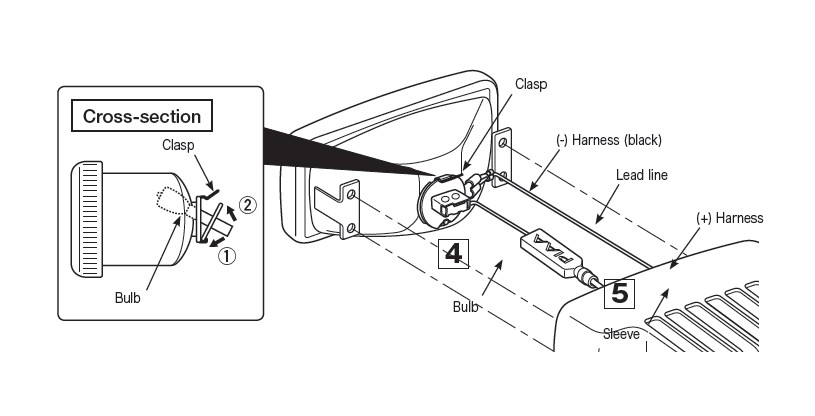
6. Combine the main unit of the lens and lamp housing. Use the 4 screws to firmly fix the unit into place.
CAUTION:
● After reassembling the unit, make sure the harness is not inadvertently caught in the lamp assembly. Such conditions may cause a short. It may also cause water to seep into the unit.
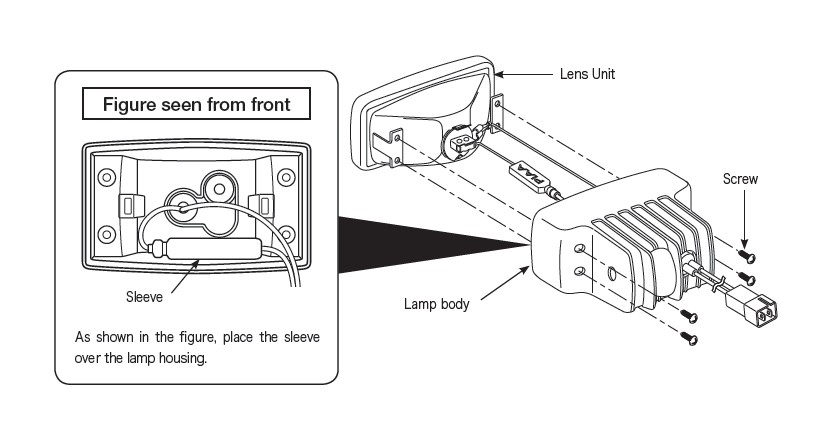
7. Gently pull the lamp harness and pull out excess slack from inside the lamp.
8. Re-adjust the angle of the lamps beam
7. Troubleshooting
1 After installation, if the lamp does not activate
→ Check the wiring and make sure there are no faulty or irregular connections .
● If the switch illumination does not light up.
→ Verify the ( ) wire from the switch is properly connected. If it is not correctly connect it will not activate.
→ Verify the fuse located on the vehicle' s wiring system. (the switch' s ( ) wire should be connected to the fuse box). If it is burned out, connect it to another circuit.
→ Check the fuse for the relay harness. If it is burned out, follow instructions indicated in [ 3 Fuse replacement Procedures].
● The switch illumination lights up but when operating it an audible “click” is not heard.
→ If the switch itself is faulty, the same symptoms may exist. We recommend that the entire switch unit be replaced.
● The switch illumination lights up but when operating it an audible “click” can be heard.
→ Check the bulb. If it is burned out replace it accordingly. 2 If the bulb suddenly fails to light up ...
→ Check the bulb inside the housing and if it is burned out replace accordingly.
→ Check the fuse located in the vehicle. If it is burned out, replace accordingly.
→ Check the fuse for the relay harness. If it is burned out, follow instructions indicated in [ 3 Fuse replacement Procedures].
→ There may be cases where each terminal related to specific sections may be incorrectly connected. Check for any lose wires and also for dirt or grime.
→ Water or incorrect connection may cause an irregular electric current flow, which could damage the relay. Replace the relay and check each section of the relay installation position and wiring.
→ Check the switch. If an abnormality is found, replace it accordingly.
3 Fuse replacement Procedures
→ A short circuit may have occurred. Check the lamp interior and wiring system. If any type of damage is found replace accordingly. (Non-replacement may pose a potential danger) (Short circuits are mainly caused when wires are caught in the assembly or when there is a gap in the sleeve connected to the lamp harness. Be extremely careful when reassembling the lens unit or replacing a bulb.
→ Verify the wattage capacity of the relay harness is accurate. Using a bulb that exceeds the relay harness wattage can be potentially dangerous. Always use bulbs that correspond to the wattage specified.
4 If light fails to turn off
→ The relay may have been damaged due to permeation of water or faulty connection. Replace relay and make thorough check of installation and wiring system.
→ Check the switch button. If an abnormality is found, replace accordingly.
5 If water permeates the interior of unit
※ The lamp goes through a “breathing” action. After the lamp is turned on, if it fogs up and then clears after 2 or 3 minutes there is no problem.
→ Check the proper direction of lens. Always set lamp so that the PIAA logo is upright.
→ Check to makes sure that the ventilation on the rear section of the lamp is not rubbing against the bumper. Also check that it is not facing upwards. Make sure the ventilation faces downward and does not rub against the bumper.

